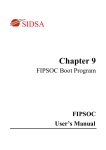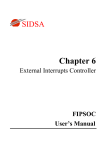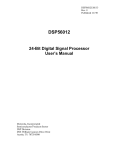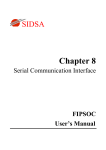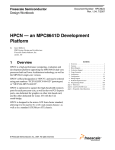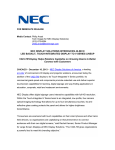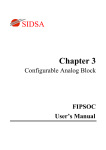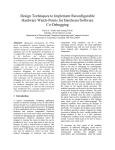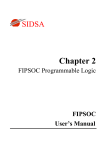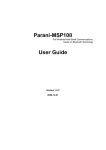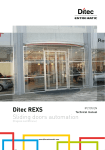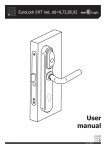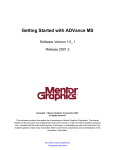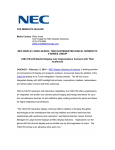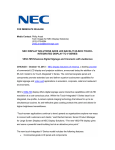Download FIPSOC User Manual
Transcript
SIDSA Chapter 4 On-Chip Subsystems Interface FIPSOC User’s Manual SIDSA Semiconductor Design Solutions On-Chip Subsystems Interface Overview The Field Programmable System On Chip (FIPSOC) constitutes a new concept in system integration. It provides the user with the possibility of integrating a microprocessor core along with programmable digital and analog cells within the same integrated circuit. This chip can be considered as a large granularity FPGA with a FPAA (Field Programmable Analog Array) and a built-in microprocessor core that does not only act as a general purpose processing element, but also configures the programmable cells and their interconnections. Therefore, there is a strong interaction between hardware and software as long as signal values and configuration data within the programmable cells are accessible from microprocessor programs. This chapter describes the communication interface between the built-in 8051 and the programmable blocks integrated on the FIPSOC chip. The mP8051 has two functions: firstly, it configures each of the onchip subsystems; secondly, after the programmable blocks are configured, it is used as general purpose microprocessor. Thus, the interface circuitry among the different blocks has been optimized. Both configuration and data exchange is made through the memory map of the built-in 8051 core. This enhanced memory organization keeps, by default, the map distribution of the original 8051. New registers included in the SFR area of the 8051 have been added for system and memory organization control purposes. Manipulating these registers, the memory organization of the processor may dynamically change. With accurate programming, the mP8051 is able to configure and control the programmable blocks through its internal and external memory and SFR areas. The Regular Configuration Memory of the Programmable Logic Block has a double function: Chapter 4. On-Chip Subsystems Interface firstly, it is used as a buffer memory for the configuration registers of the DMC (new configuration is not updated until a transfer command is sent); secondly, it can be used as general purpose on-chip memory, so no external memory is needed. 1. 8051 Memory Organization The memory map of the on-chip mP8051 keeps, by default, the memory organization of the original 8051. That is, it has a separate address space for Program Memory and Data Memory, distributed in the following four addresses spaces: • • • • Up to 64 Kbytes of Program Memory, Up to 64 Kbytes of external Data Memory, 256 bytes of internal Data Memory, 128 bytes of Special Function Registers area. On the FIPSOC chip, two memory areas have been added, overlapped with the original memory areas, with the purpose of accessing to the different configuration memories and control registers of the onchip peripherals of the 8051. These locations, whose mapping is configured by Special Function Registers, are mapped in the following two spaces: • 64 bytes of internal data memory, called buffer access area, • Up to 16 Kbytes memory mapped on the lower external Data Memory (depending on device) 1.1. Program Memory The Program Memory of the on-chip mP8051 consists of an internal and an external space (see figure 1.1). 512 bytes of Program Memory resides on-chip (dedicated to the FIPSOC’s Boot Program). The program memory can be externally expanded up to 64 Kbytes. The internal memory may be disabled; in that case, the 8051 fetches all instructions from the external program memory. 2 SIDSA Auxiliary Memory External $FFFF $FF00 $FEFF Semiconductor Design Solutions of RAM, the upper 128 bytes RAM area, 128 bytes of special function register (SFR) area and 64 bytes (located in $30 through $6F) of the buffer access space (figure 1.2). Both SFR area–upper RAM and lower RAM–buffer access share the same addresses locations, so they must be accessed in different ways: External a) SFR area and upper RAM are accessed trough different addressing modes (direct and indirect addressing, respectively) Internal ROM (Boot Program) $0200 $01FF External $0000 Fig. 1.1: Program Memory Address Space 256 bytes random access memory (auxiliary memory) is provided in the upper addresses space and may be simultaneously mapped in both program and data memories. If this memory is enabled, location $FF00 through $FFFF are fetched from it (see Microprocessor Document for further information). $FF Special Function Register Area Upper 128 bytes Internal RAM (direct addresing) (indirect addresing) b) The scratch pad area located in positions $30 through $6F may be disabled in order to access to the buffer access area (only one of these two memories may be enabled at a time) The lower 128 bytes are grouped in four addresses space (as shown in figure 1.3): a) Four General Purpose Registers banks ($00 through $1F), b) Next 16 bytes ($20 through $2F) contains 128 directly addressable bits, c) Location $30 through $6F can be used either as a scratch pad area or as buffer access area (as shown below) d) Location $70 through $7F can be used as a scratch pad area. Scratch Pad Area $80 $7F $70 $6F $7F $6F Buffer Access Area Scratch Pad Area Buffer Access $30 Lower 128 bytes Internal RAM $30 Bit-addressable Area Both direct and indirect addressing $00 Fig. 1.2: Data Memory / SFR Address Spaces 1.2. Data Memory The Data Memory address space consists of an internal and external memory portion. $2F $20 $1F 4 Banks for General Purpose Registers $00 Fig. 1.3: Lower portion of the Internal Data Memory • Internal Memory: It is divided into four physically separated blocks (original 8051 internal memory is only divided into three blocks): the lower 128 bytes Chapter 4. On-Chip Subsystems Interface 3 SIDSA F8 F0 Semiconductor Design Solutions ROWL ROWH COLL COLH RG1 RG2 RGTX outCOMP (00) (00) (00) (00) (00) (00) (00) (0X) B* CKCONF CKCNTL CKCNTH CKDMC2 CKDMC1 CKANA CK8051 (00) (60) (00) (00) (00) (00) (00) (6F) DBG2L DBG2H DBG3L DBG3H DBG4L DBG4H DBG5L DBG5H (00) (00) (00) (00) (00) (00) (00) (00) E0 ACC* ANAST DBGCNF DBGMSK DBG0L DBG0H DBG1L DBG1H (00) (0X) (00) (00) (00) (00) (00) (00) D8 DANA1 DANA2 DANA3 DANA4 DANA5 DANA6 DANA7 DANA8 (XX) (XX) (XX) (XX) (XX) (XX) (XX) (XX) E8 D0 PSW* FF F7 EF E7 DF D7 (00) C8 C0 B8 B0 A8 A0 CF EIMR0 EIMR1 SGNI0 SGNI1 IRS IRSCKDB (00) (00) (00) (00) (XX) (00xxxxxx) C7 IP* VHW4L VHW4H VANAL VANAH (xxx00000) (00) (00) (00) (00) PRTD* VDBGL VDBGH VHW3L VHW3H (FF) (00) (00) (00) (00) IE* VCLKL VCLKH VHW2L VHW2H (0xx00000) (00) (00) (00) (00) PRTC* VPLLL VPLLH VHW1L VHW1H (FF) (00) (00) (00) (00) 98 SCON* SBUF WDOG RG3 I2CREG BTREG DDRGP CMBUF (00) (XX) (00) (02***) (**) (**) (FF) (XX) 90 PRTB* BF B7 AF A7 9F 97 (FF) 88 80 TCON* TMOD TL0 TL1 TH0 TH1 (00) (00) (00) (00) (00) (00) PRTA* SP DPL DPH PCON (FF) (07) (00) (00) (0xxx0000) * bit addressable (Reset values of the SFRs) ** Reset value depends on general port values 8F 87 SFRs in grey only in FIPSOCs *** It depends on FIPSOCs version Table 1.1: Special Function Registers map (SFR) • External Memory: There can be up to 64 Kbytes of external data memory. Its addresses can be either 2 or 1 byte wide (using the 16 bit data pointer or an 8bit general-purpose register). Refer to Microprocessor Document for detailed descriptions. configuration memory. If this memory is enabled, lower 16 Kbytes (12, 6 or 4 Kbytes) of the external memory area are not available (some bits of a special register will select the active area). The external data memory address space is divided into four different areas (as shown in figure 1.4): c) Next 256 bytes for hardware probing and writing of the output of the DMCs. Only one of these two memories may be enabled ata a time (that is, the 256 hardware memory or external data memory) a) Up to 64 Kbytes of external data memory area (this memory is represented in four regions in figure 1.4) b) Lower 16 Kbytes (12 Kbytes, 6 Kbytes or 4Kbytes, depending on device version) can also be used for mapping on-chip subsystems Chapter 4. On-Chip Subsystems Interface d) Upper 256 bytes may be internally mapped through the auxiliary memory. Note that if the auxiliary memory is enabled both upper 256 4 SIDSA locations of data and program memories coincide. Semiconductor Design Solutions been reserved for system configuration and generalpurpose control. 1.3. General Purpose Registers The subsystems and the memory used for configuration are listed below: The lower 32 positions of the internal RAM are grouped into four banks of 8 registers. Only one of the banks may be enabled at a time (two bits of PSW register are used to select the active bank). For indirect addressing, two of them are used as pointer or index registers. a) The programmable blocks (CAB and PL block) are configured (and accessed) using special function registers and data memory (both internal and external) of the 8051 memory organization. Thus, the configuration and data transfer of these blocks is made through positions located in both internal and external memories. Auxiliary Memory Data (Region 4) $FF00-$FFFF $FEFF External Data Memory (Region 3) $1900* HW Probing Area Data (Region 2) $1800-$18FF* $17FF* PL Block Configuration Memory Area External Data Memory (Region 1) $0000 * Locations given for 12x8 PL size device Fig. 1.4: External Data Memory Space 1.4. Special Function Registers (SFR) The SFR area is located in the upper 128 bytes of the internal memory. It has two important functions: Firstly, all CPU registers reside in this area (excepting PC and GPR banks). Secondly, a number of registers (not included in the SFR area of the original 8051) constitute the interface between the mP8051 and all the on-chip subsystems. SFR, which are located in addresses which are multiple of eight, are both byte- and bit-addressable. All SFR can be accessed by direct addressing only (see Table 1.1). Note that not all of the addresses are occupied. Unoccupied addresses are not implemented on the chip (and the may be used in future). Read access to these addresses will return random data; write accesses will be ignored. 2. Subsystems Interface The configuration and control of the subsystems that are included in the FIPSOC chip are realized through accesses to locations of the different memories of the mP8051. Some memory locations of the SFR area have Chapter 4. On-Chip Subsystems Interface • Programmable Logic Block: Either internal or external memory locations may be used to configure, control and transfer data. In particular, both configuration memory and hardware outputs of the DMC are mapped in both internal (buffer access) and external; LUT memory data in DMCs can be accessed through internal memory only. • Configurable Analog Block (CAB): The configuration of the block is made through the buffer access area only; Data transfer is made using memory locations of the SFR area. b) Other subsystems are configured and controlled with special function registers only. These blocks, not described here, are the Clock Generation Block (CGB), Interrupt Service Block, Serial Communication Block, Debugger Block, Watchdog Block and other 8051 peripherals systems (Parallel & Serial I/O, Timers, etc.) 2.1. External Memory Locations $0000 through $17FF of the external memory are used to map the configuration memory of the PL block. Next 256 bytes are used to probe hardware outputs of the DMCs. Table 2.1. shows the external memory distribution for different FIPSOC models. All these memory areas may be independently and simultaneously mapped. External memory can always be disabled. When a particular memory block is disabled, its memory space becomes automatically available for external use (out of the chip through the external bus). For example, the following memory usage can be configured: ü both auxiliary memory and hardware probing registers area may be mapped, leaving the lower 16 Kbytes as the original external data memory. ü the whole 64K of the external data memory may be mapped ü Region 1, 2 and 4 of the original external data memory have been disabled in order to access to 5 SIDSA PL Configuration Memory, HW Probing Area and Auxiliary Memory, respectively Setting or clearing the values of the corresponding bits in the system control registers (see later in the document), the configuration of the memory can be changed. This re-configuration can be made dynamically; that is, non-reset between different configurations are needed. 2.2. Buffer Access The Data Buffer Area is located in $30 through $6F of the internal data memory of the 8051. By default, this portion of memory is not mapped, and the original memory organization is obtained (see figure 1.3). When buffer access area is enabled (first scratch pad area is disabled because only one of them may be active at a time), memories and registers from several different blocks throughout the FIPSOC chip can be accessed, depending on the access mode (these modes will be described in detail later in the document): • PL Block Regular Configuration Memory: Locations $30 to $4F map buffer context #0 ($50 to $6F for buffer context #1). A write operation on any of these locations writes data to all the DMCs selected with the row and column mask registers (mapped in the SFR area). A read operation should only be done with one DMC selected, otherwise the internal priority control circuit would select only the one with the bigger column and mask number. Configuration memory for the IO cells and CAB-DMCs routing resources can also be selected setting the corresponding bits included in the row and column mask registers. • PL Block LUT data memory: Locations $38 to $3F map nibbles 0 to 7 of the Low Tile of the DMC selected with the mask registers. Locations $40 to $47 map the nibbles 0 to 7 of the High Tile of the DMC selected to the mask registers. In both cases, the lowest nibble is always used. Locations $48 to $4F map nibbles 0 to 7 of both tiles, using the four most significant bits of each location for the nibble corresponding to the High tile and the four least significant bits for the Low Tile. Several DMCs can be selected for multiple write operations, while only one for reading (the priority circuit works like in the Regular Configuration Memory mode). Locations $30 to $37 and $50 to $6F are unused. • PL Block Hardware Probing memory: This access mode is intended to provide a fast way to probe hardware signals in real time, both sequential and combinational. Only the outputs of a Chip Quarter are mapped, so the appropriate Chip Quarter must be selected first with the Mapping Control Registers (mapped in the SFR area) Chapter 4. On-Chip Subsystems Interface Semiconductor Design Solutions • PL Block Hardware Writing mode: This access mode is intended to provide a fast way to write in the flip-flops of the sequential part of the DMCs in real time. Only the DMCs of a Chip Quarter are mapped, so the appropriate Chip Quarter must be selected first with the Mapping Control • CAB Configuration memory: CAB Configuration is done by writing in non-buffered conventional RAM memory. No multicontext operation is allowed for the CAB. In this mode, the buffer directly maps the whole CAB configuration memory for read and write access. No context transfer command is needed like for buffered multicontext configuration memory (DMCs and IOs). Note that the regular configuration memory registers and the hardware probing and flip-flop writing memory locations may be also mapped in the external memory. These access modes are independently configured and may be used at the same time. These memory locations cannot be reached from any program running from the programmable logic configuration memory (due to timing scheduling conflict) The data in the Regular Configuration can be used either for general purpose data or for configuring the Programmable Logic Block. Data is stored in the memory cells until a transfer command is sent (see PL Block Document for further information). 2.3. Extended SFR map The new special function registers added to the original SFR map of the 8051 are dedicated to control, configure and data transfer purpose. Only 18 of them are related to the programmable blocks interface and the system mapping control. In particular, SFR may be grouped as follows: • System Mapping Control Registers: These registers are used by FIPSOC for memory organization control and buffer access modes. They include: a) Row and Column mask (two 16-bit registers -ROW and COL- and one nibble of general control register -RG2[7:4]-), b) General Control registers (three locations, RG1, RG2 and RG3), c) Transfer command (one register, RGTX). • Analog Control Registers: Ten registers are used for (digital) data transmission with the CAB. Input registers for the DACs are written here and output registers from the ADCs and comparators are read (DANA1 through DANA8 for DACs/ADCs operations and outCOMP for comparators reading). Control commands for this block are also issued writing to one of these registers (ANAST). 6 SIDSA The new SFR map is completed with control registers of the on-chip subsystems (described in their corresponding documents). Port 3 [5:0] INT1 Port 2 [3:0] Ext. Timers 0. 1 HW 1-4 INTs. INT0 ports of 8 bits). Due to the fact that FIPSOC integrates some external peripherals on-chip, not all the 4 ports are accessible from the external system. In particular, port 2 and port 3 of the 8051 have been used for internal communication purposes (see figure 2.1) • Port 2 is utilized by the system for accesses to external memories. ü Only output direction is available (normally used as high byte address), ü Input direction of Port 2 has been dedicated for the communication between the PL block and the 8051 (PL→ 8051 direction), • Port 3 has been reserved for internal use only (except data memory strobes and RX / TX of the serial interface). ü Output of bits 0 to 5 are dedicated for the communication with the PL block (8051→ PL direction), ü Output 0 enables the TX lines of the serial interface ü Bits 2 and 3 (inputs) are reserved to interrupt signals, ü Bits 4 and 5 (inputs) are reserved for external timer purpose, and come from the PL block. PL BLOCK Interrupts. Extension. Block Semiconductor Design Solutions 8051 Fig. 2.1: Fast access bus interface (see Microprocessor Document for further information) 2.4. Port Access The original 8051 has 32 bi-directional and individually addressable I/O lines (grouped into four 8x8 12x8 16x12 16x16 $0000 to $0FFF $0000 to $17FF $0000 to $2FFF $0000 to $3FFF Regular Configuration Memory $1000 to $10FF $1800 to $18FF $3000 to $30FF $4000 to $40FF Hardware Probing Registers $FF00 to $FFFF $FF00 to $FFFF $FF00 to $FFFF $FF00 to $FFFF Auxiliary Memory Table 2.1: External memory distribution for different FIPSOC models 3. System Mapping Control SFR FIPSOC uses some Special Function Registers (SFR) of the internal memory map of the mP8051 for the memory configuration (used for programmable blocks interfaces) and general system control. These registers are described below: Column Mask Register (h00 after Reset) Address $FB,$FA Name COL COLL Byte COLH $FB $FA Description Column Mask Register Column Mask Register Low Byte Column Mask Register High Byte Row Mask Register (h00 after Reset) Address $F9,$F8 Name ROW ROWL ROWH Byte $F8 $F9 Description Row Mask Register Row Mask Register Low Byte Row Mask Register High Byte Chapter 4. On-Chip Subsystems Interface 7 SIDSA 8051 Port 3. Address Name PORTD NRD System Control Register 2 (h00 after Reset) Description 8051 Port 3 PORTD.7 NRD for external memory. Must not be cleared NWR PORTD.6 NWR for external memory. Must not be cleared PRTD5..2 5 thru 2 General Purpose TXD PRTD.1 (Output) Serial port TX ETXD PRTD.0 If cleared (=0), TX serial port is enabled. RX PRTD.0 (Input) Serial Port RX Note: Different registers are used for both read and write accesses. While writing, b11 - - - - 10 must be fixed to keep communications though the serial port. $B0 Semiconductor Design Solutions Bit Address $FD Name RG2 EPM WPM NPM SPM HOA1 Bit RG2.7 RG2.6 RG2.5 RG2.4 RG2.3 HOA0 RG2.2 AME RG2.1 EDMF RG2.0 System Control Register 1 (h00 after Reset) Address $FC Name RG1 CQDB1 CQDB0 AMI RG1.7 RG1.6 RG1.5 LMI RG1.4 HOI Bit RG1.3 HOE RG1.2 CMI RG1.1 CME RG1.0 Description FIPSOCs Control Register 1 Chip Quarter Data Buffer bit 1. Chip Quarter Data Buffer bit 0 Analog Configuration memory mapped as Int. Mem. If 1, configuration memory is mapped in the Data Buffer locations of the Internal Memory ($30-$6F) LUT Data Memory mapped as Internal Mem. If 1, LUT Data memory is mapped in the Data Buffer locations of the Internal Memory ($30-$6F) Hardware Outputs mapped as Internal Memory. If 1, hardware outputs are mapped in the Data Buffer locations of the Internal Memory ($30-$6F). Use CQDB1 and CQDB0 to select the appropriate Quarter. Hardware Outputs mapped as External Memory Configuration Memory mapped as Internal Memory. If 1, configuration memory is mapped in the Data Buffer locations of the Internal Memory ($30-$6F) Configuration Memory mapped as External Memory. System Control Register 3 (h02 after Reset, 12x8 device) Address $9B Name RG3 Bit INTM RG3.7 RG3.6 RG3.5 RG3.4 RG3.3 RG3.2 CM1 RG3.1 CM0 RG3.0 Description FIPSOCs Control Register 3 Description FIPSOCs Control Register 2 East Pads Mask bit. West Pads Mask bit North Pads Mask bit South Pads Mask bit. Hardware Outputs Access Mode 1. Hardware Outputs Access Mode 0. Auxiliary Memory Enable. If this bit is set, the Aux. memory (256x8bits) is mapped at locations $FF00-$FFFF of both external data and program memories. External Data Memory Function. If 1, external data memory is mapped in program memory locations. If this bit is set and CME = 1, the configuration memory of the Programmable Logic is used both for data and program memories . Transfer Command Register (h2F after Reset) Address $FE Name RGTX PLTB Bit RGTX.7 CTXSB RGTX.6 FCB RGTX.5 FAB RGTX.4 Description Transfer Register Programmable Logic Transfer bit. Writing to RGTX with this bit set produce a context transfer (set by RGTX.6) of the configuration in the DMCs Context Select Bit. If this bit is set when writing to RGTX with PLTB = 1, context 1 is transferred to the configuration memory of the selected DMCs. If this bit is 0, context 0 is transferred. Freezing Command Bit. A writing to RGTX with this bit set produce an start/stop action in the state machine of the clock generation block. Freezing Action Bit. If this bit is set when writing to RGTX with FCB = 1, clocks stops by SW after CKCNT. If 0, clocks restarts. RGTX.3 RGTX.2 RGTX.1 RGTX.0 Interrupt mode. If 1, extended interrupt vectors mode is entered, if 0, basic 8051 interrupt mode is selected External Memory Compatible map bit 1 External Memory Compatible map bit 0 Chapter 4. On-Chip Subsystems Interface 8 SIDSA 4. PROGRAMMABLE BLOCKS & uC INTERFACE Configuration memories and outputs of the programmable blocks (PL and CAB) may be accessed through internal and external memory locations. 4.1. PL Subsystem Interface Regular Configuration Memory: This memory may be mapped either through internal memory (data buffer access) or external memory. If a buffer access is done, row and column mask registers are needed, with the purpose of selecting the desired DMC(s), IO cell(s) or IIC (Internal Interface Cell) routing resources cell(s). Location $30 through $6F of the internal memory map will be used. If the external memory is used, each position of the Regular Configuration Memory of every DMC has its correspondence with one location on the external memory map. 4.1.1. Regular Configuration Memory Regular Configuration Memory is used to configure the DMC. For this purpose, two different memory contexts have been included in the chip. A Transfer Command is needed for the configuration change. RGTX[7:6] is used: writing to this register with bit 7 set, data stored in the selected context of the Regular Configuration Memory will be transferred to the corresponding registers (context #0 is selected if bit 6 is cleared; otherwise, context #1 is selected). See PL Block Document for further information. 4.1.1.1. Buffer Access Data buffer area is enabled by setting RG1[0] (SFR $FC). Write and read operations affect to the selected DMCs marked by the column and row mask registers (ROW and COL registers), and to the IO and IIC cells routing resources cells selected by RG2[7:4] bits (east, west, north, south IO mask nibble), as shown in figure 4.1. The buffer access area is organized in 2 blocks: ü $30 to $4F: 32 bytes map context #0 of the selected DMC, ü $50 to $6F: 32 bytes map context #1 of the selected DMC A write operation on any of these locations writes data to all the DMCs (and IO and CAD-DMC cells) selected with the row and column mask registers and IO mask nibble. A read operation should only be done with one DMC (or cell) selected; otherwise, the internal priority control would select only the one with the bigger column and row mask number (including IO mask bits as depicted in figure 4.1), or the first row/column if no one is selected. Chapter 4. On-Chip Subsystems Interface Semiconductor Design Solutions The following accesses are not valid: ü write access with column register and west and east bits cleared (write is inhibit), ü write access with row register and north and south bits cleared (write is inhibit), ü read and write operations to physically nonexist DMC or cell; in this case, write operations will be inhibit and read operations will return random data. 4.1.1.2. External Memory Access The Regular Configuration Memory is enabled when RG1[1]=1. The addresses space is divided into two areas: the lower half portion maps all the registers of context #0 and the upper locations map the configuration registers of context #1. In both portions, the address decoding is done as follows: ü The 5 least significant bits address the 32 configuration registers of the corresponding context of the DMC, ü Every 32 locations the selected DMC is changed. The selection of the DMC is arranged, firstly, from east to west and, secondly, from south to north, ü The upper half maps context #1 with the same organization as the first portion. The size and organization of the Regular Configuration Memory depend on the selected device model. Tables 4.1 shows the memory organization for the 8x12 models. By default, the memory organization version mirrors the physical PL block model integrated in the device. However, different device models have been designed to have a compatible memory map. In fact, the logical memory organization and the physical implemented memory access have been separated. In this way, each FIPSOC model can be configured to have a memory organization equal to that of any other model. For example, the user can configure the 12x8 PL device to have the same memory map than the 16x16 model. This is a convenient way to develop an application using a big prototyping device (the 16x16 model) and produce it using a smaller device (12x8) with no changes at all. Table 4.2. shows the selection of the memory organization. In the same way as data buffer access, a write and read access to a non-exist DMC has no sense. IO cells and IICs routing resources cells cannot be accessed through external memory as only internal data buffer access is allowed. 9 SIDSA Semiconductor Design Solutions COLH 7 Selected cell by the priority control circuitry High Priority IO North bit mask 8x12 model cells Selected cell ROWH 7 ROWL 0 7 Low Priority 0 COLL 7 0 Bit set IO South bit mask 0 IO East bit mask IO West bit mask High Priority Low Priority Fig. 4.1: Data buffer access Memory location $17C0 - $17FF ... DMC selected RCOL[15:0] RROW[15:0] h0080 h0080 ... ... Description (row 7, context 1) (column 11) $0C00 - $0C3F $0BC0 - $0BFF ... h0001 h0080 ... h0001 h0080 ... (row 0, context 1) (row 7, context 0) (column 11) $0200 - $023F $01C0 - $01FF ... $0040 - $007F $0000 - $003F h0001 h0080 ... h0002 h0001 h0002 h0001 ... h0001 h0001 (row 1, context 0) (row 0, context 0) Table 4.2: 12x8 model Configuration Memory Organization RG2[5:4] Memory Organization 00 01 10 11 16x16 model 16x12 model 12x8 model 8x8 model Table 4.3: Logical Configuration Memory Organization selection Chapter 4. On-Chip Subsystems Interface 4.1.2. LUT Data Memory This memory may only be mapped through the internal data buffer (setting RG1[4] bit). Read and write operations affect the selected DMC (using row and column mask register) like in the Regular Configuration Memory mode. Locations $38 to $3F map nibbles 0 to 7 of the Low Tile of the DMC(s) selected. Location $40 to $47 map the nibbles 0 to 7 of the High Tile of the DMC(s) selected. In both cases, the lowest nibble of the byte is used either in read or write access. Location $48 to $4F map nibbles 0 to 7 of both Tiles, using the four most significant bits of each location for the nibble corresponding to the High Tile and the four least significant bits for the Low Tile. Locations $30 to $37 and $50 to $6F are not used. Restrictions and priority features enumerated in the Configuration Memory section are also valid here. IO cell and IICs routing resources cells have only configuration memory. Any write or read access with a IO mask bit set has no sense. Write operations will be inhibit and a read access will return random data. 10 SIDSA 4.1.3. Hardware Memory Area This area may be accessed either through internal or external memory. Due to the fact that read and write accesses affect different signals, two modes are provided: • Hardware writing mode: This mode is intended to provide a fast way to write in the flip-flops of the sequential part of the DMC in real time, • Hardware Probing mode: This mode is intended to provided a fast way to probe hardware signals in real time, both sequential and combinational. Four different accesses are allowed for both write and read operations (selected by RG2[3:2]). Table 4.6 lists these sub-modes. RG2[3:2] Hardware Writing Hardware Probing 00 01 10 11 Single DMC context #0 Single DMC context #1 Horizontal 8-bit access Vertical 8-bit access Single DMC access (both contexts) Horizontal 8-bit access Vertical 8-bit access Table 4.6: Accesses allowed for both write and read operations 4.1.3.1. Data buffer Access This access is enabled when RG1[2]=1. In both write and read modes only the DMCs of a Chip Quarter are mapped. RG1[7:6] are used for Chip Quarter selection (see tables 4.7 and figure 4.2). Semiconductor Design Solutions RG2[7:6] Quarter Selection (horizontal access) Quarter Selection (vertical access ) 00 01 10 11 South-East Quarter (Q0) South-West Quarter (Q1) North-East Quarter (Q2) North-West Quarter (Q3) South-East Quarter (Q0) North-East Quarter (Q1) South-West Quarter (Q2) North-West Quarter (Q3) Table 4.7: Logical Configuration Memory Organization selection The different modes and sub-modes accesses allowed are described below: a) Hardware Probing modes (read operations): Sequential and combinational outputs are obtained. Different sub-modes bring as different organizations (see Table 4.9). ü Single DMC access (RG[3:2]=0X): Locations $30 to $6F map the outputs of the DMCs, one byte each DMC. The most significant nibble corresponds with the sequential output and the least one corresponds with the combinational output. ü Horizontal 8-bit access (RG[3:2]=10): Locations $30 to $4F (lower half) map the combinational outputs, two horizontally adjacent DMCs in each byte; locations $50 to $6F (upper half) map the sequential outputs, two horizontally adjacent DMCs in each byte. ü Vertical 8-bit access (RG[3:2]=11): The lower half portion maps the combinational outputs, two vertically adjacent DMCs in each byte; Locations of the upper half maps the sequential outputs, two vertically adjacent DMCs in each byte. Table 4.9 and figure 4.3 show how simultaneous access to DMC pairs is performed. Chip Quarter distribution for 8x8 model (only first quarter is occupied) Chip Quarter distribution for 12x8 model (first and partially second quarter are occupied) b) Hardware Writing modes (write operations): Flip-flops of the sequential part of the DMCs are written. Different accesses are allowed (see Table 4.9): ü Single DMC context #0 access (RG[3:2]=00): Each locations of the $30 to $6F area writes in context #0 of the flip-flops of one DMC. The least significant nibble of the locations is used in the operation. Chip Quarter distribution for 16x12 model (third and fourth quarter are partially empty) Chip Quarter distribution for 16x16 model (all quarters are occupied -no gaps exist) Fig. 4.2: Chip Quarter distribution for the different models ü Single DMC context #1 access (RG[3:2]=01): Each locations of the $30 to $6F area writes in context #0 of the flip-flops of one DMC. The least significant nibble of the locations is used in the operation. ü Horizontal 8-bit access (RG[3:2]=10): Locations $30 to $4F write in context #0 of the flip-flops, two horizontally adjacent DMCs in each byte; locations $50 to $6F write in context Chapter 4. On-Chip Subsystems Interface 11 SIDSA #1 of the flip-flops, two horizontally adjacent DMCs in each byte. ü Vertical 8-bit access (RG[3:2]=11): Locations $30 to $4F write in context #0 of the flip-flops, two vertically adjacent DMCs in each byte; locations $50 to $6F write in context #1 of the flip-flops, two vertically adjacent DMCs in each byte. Semiconductor Design Solutions ü Vertical 8-bit access (RG[3:2]=11): The lower half portion maps the combinational outputs, two vertically adjacent DMCs in each byte; Locations of the upper half maps the sequential outputs, two vertically adjacent DMCs in each byte. b) Hardware Writing modes (write operations): Flip-flops of the sequential part of the DMCs is written. Different acceses are allowed (see Table 4.9): ü Single DMC context #0 access (RG[3:2]=00): Each locations of the $00 to $FF area writes in context #0 of the flip-flops of one DMC. The least significant nibble of the locations is used in the operation. ü Single DMC context #1 access (RG[3:2]=01): Each locations of the $00 to $FF area writes in context #0 of the flip-flops of one DMC. The least significant nibble of the locations is used in the operation. Figure 4.3: Hardware Memory accesses mode Only one DMC may be selected; column and row mask registers (and IO mask nibble) are ignored in Hardware memory modes. Read and write operations to physically non-exist DMCs or cells have no sense; in this case, write operations will be inhibit and read operations will return random data. 4.1.3.2. External Memory If RG1[3] is set, Hardware Memory is enabled. The area is located in the next 256 bytes after the Regular Configuration Memory locations (see table 3.1). All the DMC are mapped through the relative locations $00 to $FF. As in data buffer access, different modes and sub-modes are allowed: a) Hardware Probing modes (read operations): Sequential and combinational outputs are obtained. Differentes sub-modes bring as different organizations (see Table 4.9). ü Single DMC access (RG[3:2]=0X): Locations $00 to $FF map the outputs of the DMCs, one byte each DMC. The most significant nibble corresponds with the sequential output and the least one corresponds with the combinational output. ü Horizontal 8-bit access (RG[3:2]=10): Locations $00 to $7F (lower half) map the combinational outputs, two horizontally adjacent DMCs in each byte; locations $80 to $FF (upper half) map the sequential outputs, two horizontally adjacent DMCs in each byte. Chapter 4. On-Chip Subsystems Interface ü Horizontal 8-bit access (RG[3:2]=10): Locations $00 to $7F write in context #0 of the flip-flops, two horizontally adjacent DMCs in each byte; locations $80 to $FF write in context #1 of the flip-flops, two horizontally adjacent DMCs in each byte. ü Vertical 8-bit access (RG[3:2]=11): Locations $00 to $7F write in context #0 of the flip-flops, two vertically adjacent DMCs in each byte; locations $80 to $FF write in context #1 of the flip-flops, two vertically adjacent DMCs in each byte. Read and write operations to physically non-exist DMC or cell have no sense; in this case, write operations will be inhibit and read operations will return random data. Note that in all the FIPSOC models, 256 bytes are dedicated to map the Hardware Memory. Gaps exist in non-16x16 models. 4.2. CAB Subsystem Interface CAB uses both data buffer and SFR maps for configure, control and data transfer. 4.2.1. Buffer Access CAB Configuration Memory may only be mapped through the internal data buffer (if RG1[5] = 1). Configuration is done by writing in non-buffered conventional RAM memory. No multicontext is provided. Locations $30 to $6F constitute the whole CAB configuration memory. Not all of the addresses are used. Unoccupied locations are reserved for future use. 12 SIDSA Semiconductor Design Solutions 4.2.2. Data transfer (through SFR area) Data transfer and fast control (such as the start command and the end of conversion signals) are mapped in the SFR area. Locations $D8 through $DF, $E1 and $FF are used (as shown in Table 4.8). SFR Register Name Access mode $D8 to $DB $DC to $DF $E1 DANA1 to DANA4 DANA5 to DANA8 ANAST (mPCONV[3:0]) ANAST (mPDONE[3:0]) outCOMP[3:0] Read and write Read Only Read Write Read Only $FF Table 4.8: Logical Configuration Memory Organization selection ü Input registers for ther DACs are written by accessing to DANA1 to DANA4 SFRs. ü Output registers from the ADCs may be obtained by reading these four registers (DANA1 to DANA4). ü DANA5 to DANA8 are read only registers and they are used in 4 input-multiplexed 10-bits ADC mode (see CAB document for detailed description). ü Outputs of the comparators section may be read by accessing to the least significant nibble of the read only OutCOMP SFR. ü ANAST registers has different functions: Writing on its bits, the corresponding ADC channel starts conversion. With a read access to the register, the end-of-conversion status is obtained. Only the least significant nibble is used. See CAB Document for further information Locations Internal External* Q0, $30 $00 Q0, $31 $01 Q0, $32 $02 Q0, $33 $03 Q0, $34 $08 Hardware Probing Mode Horizontal 8-bit ** Vertical 8-bit *** (1,0) & (0,0), comb (0,1) & (0,0), comb (3,0) & (2,0), comb (0,3) & (0,2), comb (5,0) & (4,0), comb (0,5) & (0,4), comb (7,0) & (5,0), comb (0,7) & (0,6), comb (1,1) & (0,1), comb (1,1) & (1,0), comb Hardware writing Mode Horizontal 8-bit ** Vertical 8-bit *** (1,0)&(0,0), context #0 (0,1)&(0,0) context #0 (3,0) & (2,0), ctx #0 (0,3) & (0,2), ctx #0 (5,0) & (4,0), ctx #0 (0,5) & (0,4), ctx #0 (7,0) & (5,0), ctx #0 (0,7) & (0,6), ctx #0 (1,1) & (0,1), ctx #0 (1,1) & (1,0), ctx #0 Q0, $4F Q0, $50 $3B $80 (7,7) & (6,7), comb (1,0) & (0,0), seq (7,7) & (7,6), comb (0,1) & (0,0), seq (7,7) & (6,7), ctx #0 (1,0) & (0,0), ctx #1 (7,7) & (7,6), ctx #0 (0,1) & (0,0), ctx #1 Q0, $6F Q1, $30 $BB $04 (7,7) & (6,7), seq (9,0) & (8,0), comb (7,7) & (7,6), seq (1,8) & (0,8), comb (7,7) & (6,7), ctx #1 (9,0) & (8,0), ctx #0 (7,7) & (7,6), ctx #1 (1,8) & (0,8), ctx #0 Q1, $4F Q1, $50 $3F $84 (15,7) & (14,7), comb (9,0) & (8,0), seq (7,15) & (6,15), comb (1,8) & (0,8), seq (15,7) & (14,7), ctx #0 (9,0) & (8,0), ctx #1 (7,15) & (6,15), ctx #0 (1,8) & (0,8), ctx #1 Q1, $6F Q2, $30 $BF $40 (15,7) & (14,7), seq (1,8) & (0,8), comb (7,15) & (6,15), seq (9,0) & (8,0), comb (15,7) & (14,7), ctx #1 (1,8) & (0,8), ctx #0 (7,15) & (6,15), ctx #0 (9,0) & (8,0), ctx #0 Q2, $4F Q2, $50 $7B $C0 (7,15) & (6,15), comb (1,8) & (0,8), seq (15,7) & (14,7), comb (9,0) & (8,0), seq (7,15) & (6,15), ctx #0 (1,8) & (0,8), ctx #1 (15,7) & (14,7), ctx #0 (9,0) & (8,0), ctx #1 Q2, $6F Q3, $30 $FB $44 (7,15) & (6,15), seq (9,8)&(8,8), comb (15,7) & (14,7), seq (9,8)&(8,8), comb (7,15) & (6,15), ctx #1 (9,8)&(8,8), ctx #0 (15,7) & (14,7), ctx #1 (9,8)&(8,8), ctx #0 Q3, $4F Q3, $50 $7F $C4 (15,15)&(14,15) comb (9,0)&(8,15), seq (15,15)&(14,15) comb (9,0)&(8,15), seq (15,15)&(14,15) ctx #0 (9,0)&(8,15), ctx #1 (15,15)&(14,15) ctx #0 (9,0)&(8,15), ctx #1 Q3, $6F $FF (15,15)&(14,15), seq (15,15)&(14,15), seq (15,15)&(14,15) ctx #1 (15,15)&(14,15), ctx #1 * Memory Locations are relative (absolute values depend on map organization version) ** DMCs are arranged to, first, from East to West and, secondly, from South to North of die size (8x8 for each Quarter in internal access and 16x16 for external access) *** DMCs are arranged to, first, from South to North and, secondly, from East to West of die size (8x8 for each Quarter in internal access and 16x16 for external access) Table 4.9: DMC association in vertical and horizontal accesses Chapter 4. On-Chip Subsystems Interface 13













